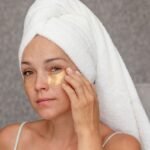When it comes to skincare, what you do before bed is just as important, if not more than your morning routine. At night, your body shifts into repair mode, and your skin begins the process of regeneration. While you rest, your skin works overtime to reverse daily damage, replenish moisture, and boost collagen production. This makes nighttime the perfect opportunity to optimize your skincare ritual for transformative results.
In this guide, we’ll explore a comprehensive, dermatologist-approved nighttime skincare ritual that works while you sleep—and the best ingredients, steps, and tips to make it truly effective.
Why Nighttime Skincare Matters
1. Skin Regenerates Faster While You Sleep
Between 10 p.m. and 2 a.m., your body ramps up cell turnover and collagen synthesis. This is the peak time for healing and renewal, which is why applying the right ingredients during this window can deliver dramatic results.
2. Less Environmental Stress
Unlike daytime, there’s no exposure to UV rays, pollution, or makeup at night. This makes your skin more receptive to active ingredients, allowing your products to penetrate deeper.
3. Boosts Skin Barrier Repair
Nighttime is when your skin barrier heals from irritants and oxidative stress. Supporting this process helps reduce inflammation, dryness, and premature aging.
The Transformative Nighttime Skincare Ritual
Ready to wake up to smoother, brighter, and more youthful-looking skin? Let’s break down the step-by-step ritual:
Step 1: Double Cleanse to Purify
Why it’s essential:
Throughout the day, your skin accumulates makeup, oil, dirt, and pollutants. A single cleanse may not fully remove them, especially if you wear sunscreen or heavy makeup.
How to do it:
- First cleanse: Use an oil-based cleanser to melt away sunscreen and makeup.
- Second cleanse: Follow up with a gentle, water-based cleanser to remove impurities and sweat.
Pro Tip: Look for sulfate-free formulas to avoid stripping your skin.
Step 2: Apply a Balancing Toner
Why it’s essential:
After cleansing, your skin’s pH can be disrupted. A toner helps rebalance, calm, and prepare your skin for better absorption of serums.
Best ingredients:
- Witch hazel (for oily skin)
- Rose water (for hydration)
- Niacinamide (for barrier repair)
Step 3: Use a Hydrating Essence or Mist
Why it’s essential:
Essences help to hydrate and plump the skin before heavier treatments. They act as a moisture magnet and improve product absorption.
Try:
- Hyaluronic acid-based essence
- Fermented ingredients for glow (like galactomyces or bifida ferment lysate)
Step 4: Target Concerns with a Serum
Why it’s essential:
This is the powerhouse of your ritual. Nighttime serums are typically more concentrated with active ingredients that work best while your skin is in repair mode.
Popular nighttime serum ingredients:
- Retinol: Boosts collagen, smooths texture
- Peptides: Firm and repair skin
- Vitamin C: Brightens and fades pigmentation
- Niacinamide: Improves elasticity and reduces inflammation
Note: If using retinol, apply only 2–3 times a week to start.
Step 5: Lock It In with a Moisturizer
Why it’s essential:
Night creams are thicker for a reason—they seal in hydration and help your skin repair overnight. Without it, all your previous layers might evaporate.
Look for:
- Ceramides (strengthen barrier)
- Squalane (moisturizes without clogging)
- Shea butter or jojoba oil (deep hydration)
Step 6: Eye Cream for Delicate Areas
Why it’s essential:
The skin around your eyes is thinner and more prone to wrinkles. Using a specialized product can help reduce puffiness and fine lines.
Top ingredients:
- Caffeine (de-puffing)
- Peptides (firming)
- Retinol (wrinkle-smoothing, use sparingly)
Step 7: Overnight Mask or Sleeping Pack (2–3x/week)
Why it’s essential:
A sleeping mask gives your skin an extra dose of nourishment. Think of it as a night-long treatment session.
Choose based on need:
- Dry skin: Hyaluronic acid mask
- Dull skin: Vitamin C sleeping pack
- Aging skin: Peptide-rich formulas
Ingredients That Work Best Overnight
Here’s a list of top ingredients that enhance skin repair during sleep:
| Ingredient | Benefits |
| Retinol | Cell turnover, anti-aging |
| Hyaluronic Acid | Hydration boost |
| Peptides | Skin firming |
| Niacinamide | Brightening, soothing |
| Ceramides | Barrier repair |
| Squalane | Lightweight moisture |
| Vitamin E | Antioxidant protection |
Lifestyle Habits to Maximize Your Nighttime Skincare
A solid skincare ritual is only part of the equation. For truly transformed skin, pair it with these sleep-related habits:
1. Get Enough Sleep (7–9 Hours)
Lack of sleep increases cortisol, which breaks down collagen and causes dullness. Prioritize your rest.
2. Sleep on a Clean Silk Pillowcase
Silk reduces friction, prevents creases, and is gentler on acne-prone skin.
3. Avoid Screens Before Bed
Blue light exposure reduces melatonin and disrupts your sleep cycle—indirectly affecting your skin health.
4. Hydrate Internally
Drink a glass of water before bed to keep your skin hydrated from within.
Night Skincare Routine by Skin Type
Dry Skin:
Focus on deep hydration with hyaluronic acid, squalane, ceramides, and avoid drying actives like alcohol-based toners.
Oily/Acne-Prone Skin:
Use lightweight gel moisturizers, niacinamide, and salicylic acid-based treatments. Avoid pore-clogging oils.
Combination Skin:
Spot-treat oilier zones and use hydrating layers across the face. Balancing products like niacinamide are great here.
Sensitive Skin:
Stick with fragrance-free products. Use ingredients like centella asiatica, panthenol, and oat extract.
Final Thoughts
Your skin’s true transformation happens not during a facial or spa treatment but in your bedroom, while you sleep. By following a well-structured, ingredient-rich nighttime skincare ritual, you unlock your skin’s natural ability to repair, renew, and glow.
So tonight, take the time to cleanse, nourish, and hydrate. Your future self (and your mirror) will thank you.








